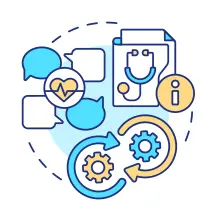
Strategies for Creating and Delivering Efficient EHR Training Content are at the forefront of revolutionizing healthcare education. In a rapidly evolving industry, where electronic health records play a pivotal role, the need for effective and tailored training cannot be overstated.
This guide explores the innovative approaches that empower healthcare professionals to excel in their roles and drive improvements in patient care. From customized learning paths to AI-powered support, these strategies are the building blocks of a successful EHR training program. Join us on a journey to unlock the potential of EHR training, a dynamic force that enhances healthcare services and optimizes operations
Crafting Effective EHR Training: 8 Strategies for Success
Discover the key to success in healthcare with Strategies for Creating and Delivering Efficient EHR Training Content. These creative methods serve as the cornerstone of an efficient EHR training program that enables medical professionals to flourish in their positions.
1. Customized Learning Paths
Imagine customized learning paths as tailor-made outfits designed to fit healthcare professionals perfectly. EHR training is not a one-size-fits-all endeavor. Various healthcare roles require distinct skill sets. By personalizing training content, you ensure that each individual receives precise, effective, and engaging guidance tailored to their unique needs. For instance, nurses might need to focus on patient record management, while physicians may require in-depth knowledge of order entry systems. Customization guarantees that each healthcare professional gets the right EHR training for their specific role.
2. Microlearning Modules
Microlearning takes intricate EHR concepts and breaks them down into bite-sized, easily digestible modules. These short bursts of information are akin to quick, nutritious snacks that fuel your knowledge without overwhelming you. For busy healthcare professionals, microlearning provides the flexibility to squeeze in valuable learning moments throughout the day. It’s like having a series of quick power snacks that keep them fueled and focused, even in the midst of their hectic schedules.
3. Mobile Learning
In today’s fast-paced world, mobile learning is the hero we’ve all been waiting for. It offers accessibility and flexibility while seamlessly adapting to the on-the-go lifestyle of healthcare professionals. Picture a nurse diving into an EHR module in between patient visits or a physician delving into EHR intricacies from the comfort of their couch. Mobile learning fits conveniently into their pockets, ensuring they have their training materials at their fingertips wherever they go.
4. Video-based Tutorials
Utilizing short video tutorials is a highly effective method for conveying complex EHR processes and workflows. These visual learning tools engage learners and facilitate a more intuitive understanding of intricate details. Video-based tutorials offer a dynamic and interactive approach to delivering essential EHR training content, ensuring it is both informative and engaging. It’s like having an expert guide you through the intricate world of EHR, making the learning experience engaging and enjoyable.
5. Data-driven Insights
Data is not just a collection of numbers; it’s a wellspring of wisdom. Analyzing training data is akin to the rigorous training of a Jedi Master, ensuring your EHR training program evolves in harmony with the needs of your learners. Think of yourself as a training coordinator equipped with the power of data analysis. These insights help you make informed decisions and adapt your approach for maximum impact, ensuring your training program remains relevant to the ever-evolving needs of healthcare professionals.
6. Peer Assessment and Collaboration
Encouraging peer assessment and collaboration is a powerful way for healthcare professionals to learn from one another. They can exchange EHR best practices, draw from their peers’ experiences, and collectively deepen their understanding. This collaborative approach not only enriches their knowledge but also fosters a supportive learning environment. It’s like a team of healthcare professionals embarking on a collective learning journey, each contributing their unique expertise to the benefit of all.
7. AI-powered Chatbots
Integrating AI-powered chatbots into your EHR training program is akin to having a knowledgeable assistant available around the clock. These virtual helpers provide real-time answers to queries, offer guidance, and help troubleshoot issues. Think of them as the friendly hospital receptionist who is always ready to assist patients. They ensure continuous learning and support, making it easier for healthcare professionals to seek assistance whenever they need it, just like having a helpful colleague by their side.
8. Continuous Feedback
Feedback is more than just a feature; it’s the compass that guides the learning journey. Continuous assessments and support mechanisms help healthcare professionals track their progress, identify strengths, and address areas that need improvement. It’s the mechanism that propels them forward by providing clear direction and helping them stay on course, much like a beacon of light guiding them through the learning process.
Conclusion
In summary, the landscape of EHR training is changing quickly, and these Strategies for Creating and Delivering Efficient EHR Training Content and delivery offer a path to success. Robust EHR training programs are built on a foundation of personalized learning pathways, microlearning modules, mobile accessibility, video lectures, data-driven insights, peer collaboration, chatbots powered by AI, and ongoing feedback.
Healthcare practitioners can confidently and skillfully negotiate the challenging landscape of electronic health records by adopting these tactics. The world of healthcare is always evolving, and in order to keep up with the demands of industry professionals, EHR training must also be flexible and always improving.
EHR training aims to improve patient care, increase productivity, and guarantee the best results—it is not just about technology. By utilizing these techniques, healthcare institutions can enable their employees to become proficient in EHR systems, leading to improved patient care. Let these strategies serve as our compass going ahead to make sure that EHR training continues to be a powerful and innovative force in the healthcare industry.






















